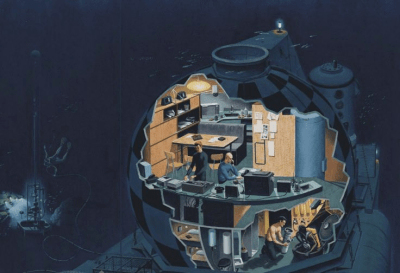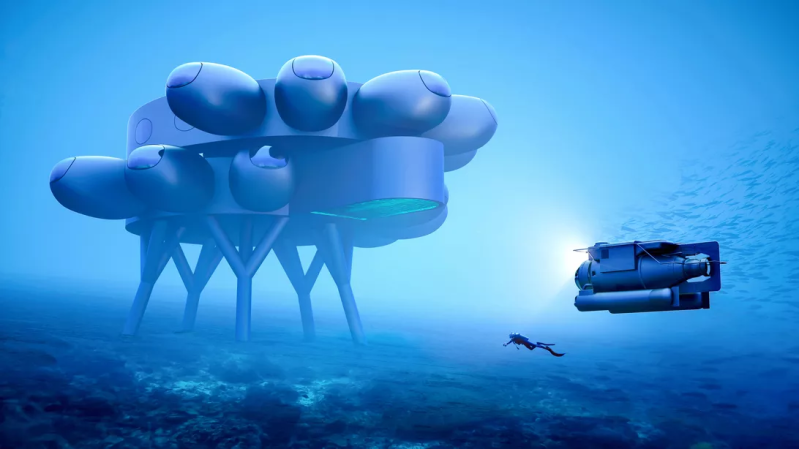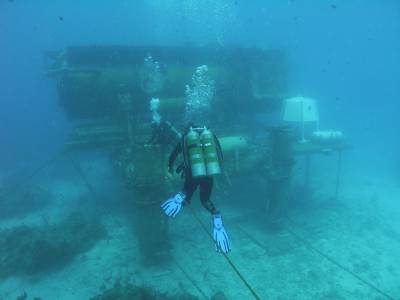The Earth’s oceans are a vast frontier that brims with possibilities for the future of medicine, ocean conservation, and food production. They remain largely unexplored because of the physical limits of scuba diving. Humans can only dive for a few hours each day, and every minute spent breathing compressed air at depth must be paid for with a slower ascent to the surface. Otherwise, divers could develop decompression sickness from nitrogen expanding in the bloodstream.

In the 1960s, world-famous oceanographer Jacques Cousteau built a series of small underwater habitats to extend the time that he and other researchers were able to work. These sea labs were tethered to a support ship with a cable that provided air and power.
Cousteau’s first sea lab, Conshelf 1 (Continental Shelf Station) held two people and was stationed 33 feet deep off the coast of Marseilles, France. Conshelf 2 sheltered six people and spent a total of six weeks under the Red Sea at two different depths.
Conshelf 3 was Cousteau’s most ambitious habitat design, because it was nearly self-sufficient compared to the first two. It accommodated six divers for three weeks at a time and sat 336 feet deep off the coast of France, near Nice. Conshelf 3 was built in partnership with a French petrochemical company to study the viability of stationing humans for underwater oil drilling (before we had robots for that), and included a mock oil rig on the nearby ocean floor for exercises.
Several underwater habitats have come and gone in the years since the Conshelf series, but each has been built for a specific research project or group of tasks. There’s never really been a permanent habitat established for general research into the biochemistry of the ocean.

Jacques Cousteau’s grandson Fabien believes the luxury lab’s time has come. He’s in the process of raising $135 million USD to build and launch what would be one of the largest underwater habitats in existence. Cousteau and his partners are looking to build a marine version of the International Space Station — a long-term livable habitat that can support a dozen researchers for several weeks at a stretch. The new lab will be called Proteus after the shape-shifting Greek god who could see the future, but answered only to those who could capture him.

The largest existing underwater habitat still in operation today is the Aquarius Reef Base, which was built in 1986 and is about the size of a school bus. Aquarius is parked 62 feet deep and roughly 5.5 miles off the coast of Key Largo, Florida, which makes it convenient for NASA to use for preparing astronauts for the harsh environment and crushing isolation of space.
Several years ago, Fabien Cousteau and his crew of aquanauts spent 31 consecutive days on Aquarius and gathered a large amount of research that he estimated would have taken two years to collect with daily scuba dives.
Cousteau’s lab will be roughly ten times the size of Aquarius at a roomy 4,000 square feet, and will comfortably house twelve people for many weeks at a time. Proteus will sit 60 feet deep off the coast of Curaçao, an island in the Caribbean. The site mapping is scheduled to be completed this fall, and opening is slated for 2023.
This futuristic-looking lab is being designed by Yves Béhar’s industrial design company Fuseproject. The idea is to build a modular habitat with room to expand in the future. In addition to research labs, living quarters, and sleeping quarters, Proteus will have a video production room and a hydroponic greenhouse to determine whether food can be grown more quickly underwater. It will be powered by a combination of wind, solar, and ocean thermal, which will be delivered along with Internet access by an umbilical cord to the surface, presumably to a support ship.
Proteus may look like the lair of an amphibious Bond villain, but it will only be used for good. The estimated $3 million per year operating cost will be offset by visiting researchers, universities, and corporations who will be allowed to rent Proteus to study anything they want except warfare. Watch Fabien Cousteau discuss his hopes for Proteus in the video below.
















AirBnB? More like WaterBnB…
NitroxBnB? TrimixBnb? HelioxBnB? HydrelioxBnB? HydroxBnB? I could go on but that’s all the breathing gasses listed on Wikipedia/.
Looks straight out of Subnautica!
This article seems like something Scientific American would publish. I’d like to see Hackaday stay more focused on things like the original labs or Aquarius and the hacks it’s taken to get them to work or (for Aquarius) to keep it alive all this time. A few Industrial design sketches is far short of a working product (forgive my skepticism).
“but it will only be used for good.” I feel like I’ve heard this phrase before. Maybe I should use Google to see who said it…….. Fool me once (or five times) shame on you, fool me again, we’ll let just say I’m going to try and keep optimizm that cousteau’s vision of preserving the world’s oceans has been adopted by his ancestry and truly is only used for good.
Highly public undersea research and exploration used as a cover for a military intelligence you say?
Never heard of it.
https://en.wikipedia.org/wiki/Project_Azorian
They missed an opportunity to name it ‘SeaLab’. It is 2020 after all.
I’m a big fan of Cousteau who invented SCUBA and researched the undersea world from Calypso using mini subs – so cool looking. National Geographic recently returned to the sites and they’re all rusted hulks on the seafloor. We and I speak internationally must build a major research facility underwater to seriously undertake the task of saving our oceans.
I am also a huge fan. I read his books and followed everything very closely. But the Calypso “discoveries” have all turned out to be dramatizations of well known creatures and phenomena. When they came to my area to look for giant octopus, they did just a little diving with locals who used to “octopus grapple” and used some footage from the 1950’s one of them made for sea-monster B movies and Sea Hunt TV show. The Calypso and crew are better represented by the parody bio film “The Life Aquatic with Steve Zissou”, which contains a number of events from the Calypso’s travels. The French accent narrator voice in Sponge Bob is Cousteau inspired.
Still, the little subs were amazing and the Nat-Geo specials were thrilling. I suppose it is hard for younger people today to understand that nobody knew squat about the underwater environment and biomes before the 1950’s and 60’s beyond what was seen by hard-hat divers going for sponges or salvage. (Highly recommend – “The Raising of the S51” – a submarine that went down in 1925. They basically had to invent everything about salvage diving . I see it is na eBook now.)
Which James Bond movie is this from?
The Spy Who Loved Me.
https://en.wikipedia.org/wiki/The_Spy_Who_Loved_Me_(film)
I wish him well, and I hope he exceeds the intended design in one way. That is, 60 feet down is shallow enough for large, fully-laden cargo ships to hit it (see “Seawise Giant” for a ship that had a draft of over 80 feet). I always wonder why structures similar in size to an anchored oil rig are not placed over undersea habitats as protection. Not that the overhead structure would have to be a true oil rig (they’re costly and they have a nasty habit of catching fire), but the presence of protective structures above and around the underwater habitat could shield it from intentional and accidental ship traffic. Would anyone know such structures aren’t used?
Since the lab is only 60′ deep why not have it attached to a surface platform to make transfer to and from the lab easier? 60′ isn’t a very long elevator shaft.
Because they want to have divers able to go in and out at any time without needing to go through decompression. A shaft to the surface with an airlock decompression chamber would be useful for a dry exit. That would make it much easier to get someone with an injury out, and to get medical people in fast to treat injured people so they can hold on long enough for decompression.
It would also be useful for personnel who won’t be doing any diving to enter and exit the habitat.
The need for decompression is a function of depth (so pressure) and time at that depth. If they had a ‘dry’ air-lock at the surface or required guests to always dive is irrelevant, breathing at 60 foot down, (going from charts) you always need a decompression stage.
Even if you dived at shallow depths such that you don’t need a staged return, doesn’t mean you aren’t affected by nitrogen absorption into the blood. One still needs to be careful how soon after a dive it is before you board a plane or go up a mountain due to the reduced pressure (relative to sea-level) those environments present.
“Only used for good” that doesn’t generate income – just a tax sink for a wealthy “philanthropist “
There’s got to be more resources down there we can exploit …
I’ve seen this movie, it doesn’t end well for most of them.
We might it one of these years. Less land in some areas on Earth as oceans rise due to the polar ice caps melting. Not to mention that when the climate gets too warm, living under the water may be the only way to survive.
SeaLab 2021?
That bodes well…
Why not grab a nuclear sub, modify it for civilian use by removing all the weapons and replace it with sciency stuff and use that as an under water laboratory?
“grab a nuclear sub”…
B^)
Seriously, there was the former Soviet sub (diesel electric) that gave tours in Seattle years ago. But the last time I went to Seattle (and hoped to board it) it was gone.
Sealab was real: https://en.wikipedia.org/wiki/SEALAB
Sealab II (1965) was the most successful. Three teams of divers lived for two weeks at a time in the habitat at 200 feet depth. Former Mercury astronaut M.Scott Carpenter stayed for 30 days. This was before the days of electronic de-garbling devices, so:
“A sidenote from SEALAB II was a congratulatory telephone call that was arranged for Carpenter and President Lyndon B. Johnson. Carpenter was calling from a decompression chamber with helium gas replacing nitrogen, so Carpenter sounded unintelligible to operators.[13] The tape of the call circulated for years[when?] among Navy divers[who?] before it was aired on National Public Radio in 1999.[14][15]”
That’s cool. Why not just use a large submarine instead though. Do the militaries of the world ever sell off their old ones? Besides being already built they would have the advantage of being mobile. Sailors already spend months at a time in them so it should work. Do they have airlocks for divers? If not then maybe those would need to be added.
They need to keep swimming in order to breathe.
Did we learn nothing from the Abyss?
Abyss was the first thing that came to my mind while reading this
I want SeaQuest not SeaLab
Couldn’t we have SI units, please? Most of the readers here are not from the States
You can have all the units! (But most of our readers _are_ in the USA.)
Then maybe include them in parentheses? or have a site wide setting to convert those to SI (it’s 2020 after all, we have JavaScript, even here)
This guy above has a fair point. Furthermore, I think Antonio is on the right, as Alexa site says only around 1/4 of folks reading are in the US
Source here -> alexa.com/siteinfo/hackaday.com
Double check just for the doubts -> similarweb.com/website/hackaday.com
One more just in case -> siteencyclopedia.com/hackaday.com/
So I don’t really think US makes up more than 40% of readers.
Are you seriously trying to tell the guy who runs the site where his views are coming from? Has it occurred to you he might have more accurate analytics than these third party estimates?
Nah dude, I’m just stating the facts I have. What you say, though reasonable, it’s still a hunch. I prefer hard data.